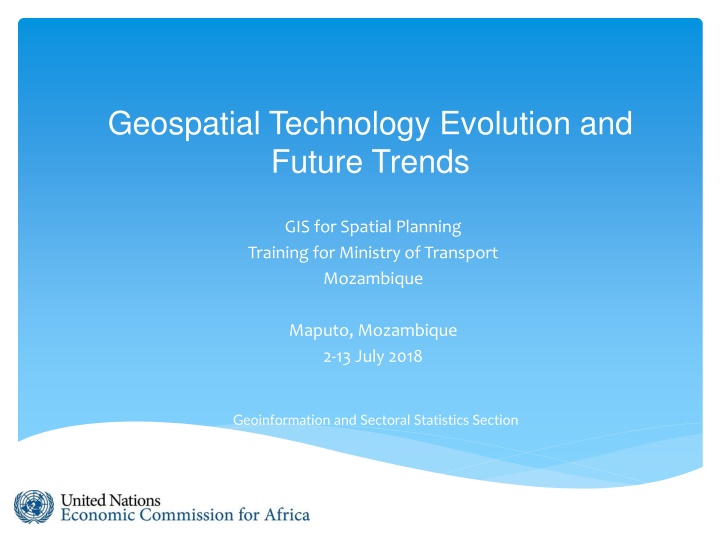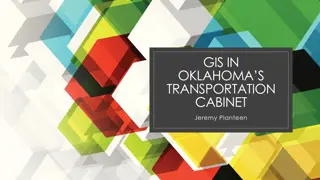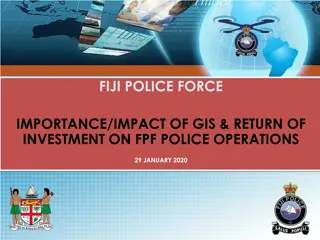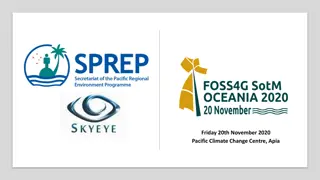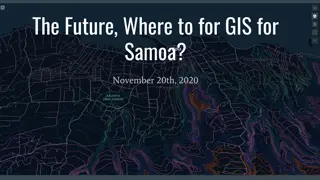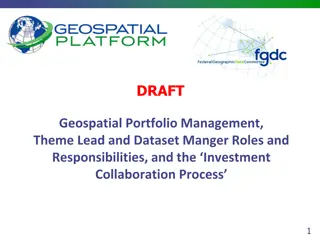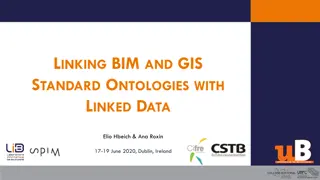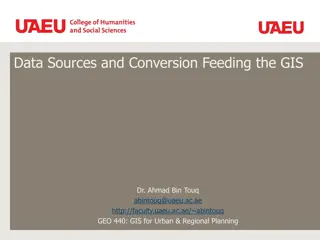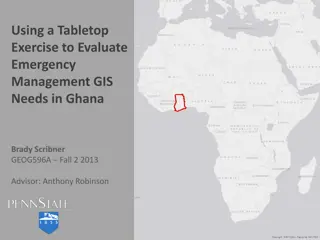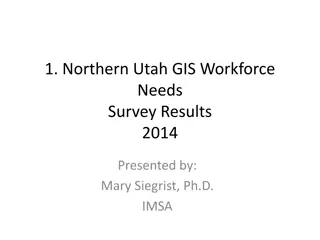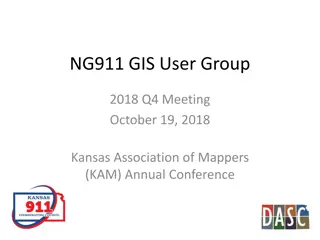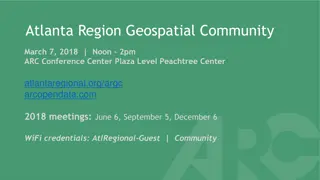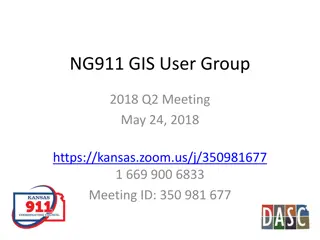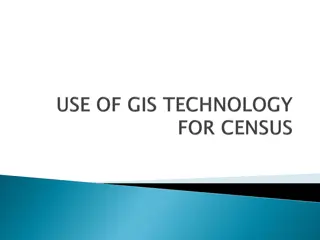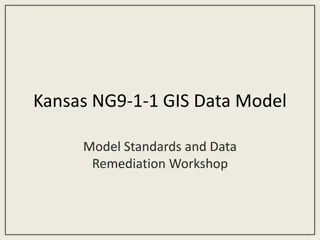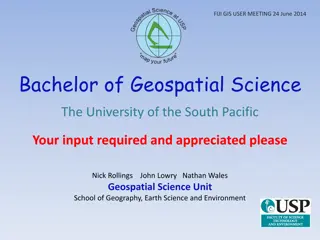Geospatial Technology Evolution and Future Trends in GIS
Geospatial technology has seen rapid evolution in recent years, transitioning from traditional paper atlases to dynamic web mapping and distributed processing. The growth in GIS technology, alongside advancements in mobile devices and cloud computing, has revolutionized spatial planning and location-based services. Explore the present and future trends shaping the field, from interactive maps to location-aware services.
Download Presentation

Please find below an Image/Link to download the presentation.
The content on the website is provided AS IS for your information and personal use only. It may not be sold, licensed, or shared on other websites without obtaining consent from the author.If you encounter any issues during the download, it is possible that the publisher has removed the file from their server.
You are allowed to download the files provided on this website for personal or commercial use, subject to the condition that they are used lawfully. All files are the property of their respective owners.
The content on the website is provided AS IS for your information and personal use only. It may not be sold, licensed, or shared on other websites without obtaining consent from the author.
E N D
Presentation Transcript
Geospatial Technology Evolution and Future Trends GIS for Spatial Planning Training for Ministry of Transport Mozambique Maputo, Mozambique 2-13 July 2018 Geoinformation and Sectoral Statistics Section
Content 1. Geospatial Technology Evolution Static and interactive maps and atlases Web mapping and distributed processing Google maps, Google Earth 2. Current and Future Trends User generated content / Volunteer Geographic Information Cloud computing
Geospatial Technology Evolution GIS technology has evolved during last few decades GIS technology is growing at faster rate both in hardware and software development In recent years, traditional paper atlases have been replaced by electronic versions Static and interactive atlases Interactive atlases are now common: allowing users to manipulate the data sets GIS servers are already providing the software architecture to enable multi-user access, serving maps and data on the Web Distributed GIS, distributed processing Web maps, web services, 3
Geospatial Technology Evolution Web maps such as Google maps, and Google Earth Google maps, and Google Earth in Tablets, Smart Phones Getting driving directions, selecting destination for family vacation, navigate through the city, etc. Mobile, wireless and location aware devices are currently used for maps and location based services (LBS) A Location-Based Service (LBS) is an information service, accessible with mobile devices through the mobile network and utilizing the ability to make use of the geographical position of the mobile device 4
Geospatial Technology Evolution Advances of mobile devices such as smart phones and wireless communications technologies facilitated spread of LBS Services to identify a location of facilities and businesses (e.g. hospital, restaurants, fuel stations, etc.) personal navigator, travel directions traffic information service, weather services proximity service (nearest ATM machine, nearest restaurant, etc.) Technologies behind LBS is positioning, with the most widely recognized system being GPS Wireless communications technologies, including wi-fi (Wireless Fidelity) and cellular network also facilitate its spread
Geospatial Technology Evolution Cloud computing is a computing paradigm for enabling on-demand network access to a pool of computing resources (e.g. networks, servers, storage, applications, and services) Presents the idea of distributed computing: Moving applications, services, and data from local storage to a dispersed set of servers and datacenters Cloud based GIS/Geo Cloud: adopts cloud computing technology to provide GIS capabilities on the cloud User can use a provider s infrastructure and GIS capabilities It lets someone else install, host, and manage it on remote servers 6
Geospatial Technology Evolution Cloud computing Model 7
Geospatial Technology Evolution ArcGIS.com, makes maps and applications available online for everyone. It allows the user to browse ArcGIS online content published by ESRI and the user community Can upload own content and share it with the user community Users can create their own story maps online to tell story on any theme 8
Current and Future Trends of GIS Google Earth is a good example of cloud-like computing. It seamlessly brings together imagery from numerous datacenters ESRI ArcGIS.com and ArcGIS Online provide cloud-based software and services, user storage, and access to GIS tools and imagery to the GIS community ArcGIS Online: enables users to use diverse web resources, including those offered by the ESRI ArcGIS Online cloud and those contributed by the user community 9
Current and Future Trends of GIS Crowd sourcing is the act of outsourcing tasks, traditionally performed by an employee or contractor, to an undefined, large group of people or community (a "crowd"), through an open call Maps can be worked on by individuals, and communities crowd sourced, enabling them to place information on base maps User Generated Content (UGC) is content that has been contributed by Web users (e.g. Wikipedia, YouTube, Facebook, etc. ) Volunteered geographic information (VGI) is UGC of a geospatial nature VGI is digital spatial data that is created voluntarily by citizens rather than by formal data producers Wikimapia and OpenStretMap use Web-based crowd-sourcing technologies, which outsource tasks to the crowd to collect data WikiMapia: is an online editable map, where users contribute geographic information describing the place on a map 10
Current and Future Trends of GIS Open Geospatial Web Services Geospatial Web services are, and will continue to be, the heart of Web GIS. A main basis of cloud-based GIS GIS professionals can serve their authoritative data and knowledge as Web services 11
Current and Future Trends of GIS Towards Ubiquitous GIS LBS will continue to develop with the increased integration of GPS functionality with increasingly powerful mobile devices (cell phones, PDAs, laptops, etc.) Web GIS is becoming ubiquitous - it is available on our desktops, laptops, cell phones, GPS navigators, and other mobile devices anywhere, anytime The omnipresence of GIS/ubiquitous will make mobile GIS available to anyone, at anytime, and anywhere. 12
